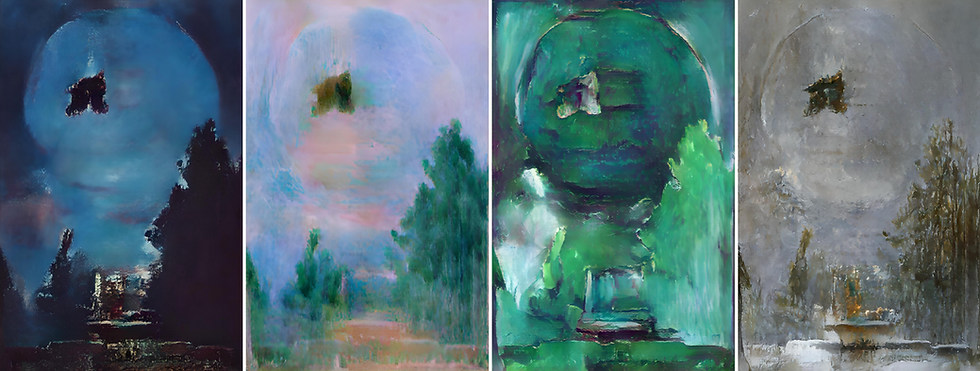The Hues
- Bob Bjarke

- Jan 16, 2022
- 3 min read
AI learns about our world through datasets. Training an AI model on a dataset essentially teaches it to understand and mimic the data in the set. For example, I might train an AI model with the complete works of Mark Twain and then ask the model to generate more text in the style of Twain. Or I might upload thousands of pictures of apples and ask the model to generate new images of apples.
I'm drawn to this process: teaching AI about our world and asking AI to contribute to it.

Fig 1. 18 AI renderings of "night" from original source image (top left)
This process of observing and mimicking feels very human. In fact, "observational learning" (the process in which humans observe the behavior of others and repeat it) is core to human learning, especially in children. We learn by observation, and these observations inform our own behavior. In experimenting with AI, I'm drawn to this process: teaching AI about our world and asking AI to contribute to it. Through AI technology like GPT-2 (a sophisticated but accessible text generation model), AI is able to generate text that is very similar to the the training data it observes. As I train AI models and use these models to generate new text, the questions I'm asking are:
What makes AI-generated text different than human-generated text?
What can we learn about ourselves from the differences?
And how can we use AI-generated text to open our minds to new ideas and connections that we might not have allowed ourselves to imagine?
For example, I trained an AI model on a dataset of 10,000 band names from the last 50+ years of popular music, and I asked the model to generate new band names for me. The model did generate some new band names, like "Karl Marx And The New Left" and "The Hues That Make Up The Night," both of which are fantastic band names. But the model also did something I didn't expect: the vast majority of results were not new band names but instead new and novel combinations of existing bands and artists. For example, "Counting Crows Featuring Lil Wayne," "Barry Manilow with The Wailers," and "Miley Cyrus Featuring Miley Cyrus" were all generated by this model. Only after going back through the dataset did I understand why. The dataset was full of collaborations: many, many songs (especially since the late 80's-early 90's) were credited to more than one artist ("Dua Lipa Featuring DaBaby", "Drake Featuring Lil Wayne & Rick Ross," or "Paul McCartney with U2") and this essentially taught the model that band names consist of more than one artist. This is the kind of connection that AI can expose us to. By holding up a mirror to the culture we have created and observing what we've built, AI generated new combinations that I wouldn't have come up with on my own. As far as I can tell, Barry Manilow never did play with The Wailers, but now that you mention it a reggae version of Mandy could be 🔥.
"The Hues That Make Up The Night" is another great example. As a piece of language it's poetic, it paints a beautiful picture of a nighttime scene and provokes us to look deeper at something we might not normally examine: the night is generally a dark time that we don't associate with hue or color. But on second thought, aren't there subtle differences in the color of night depending on where you are, what time it is, the weather, etc? Even more surprisingly, "The Hues That Make Up The Night" is a phrase that turns up zero results on Google.
I'll use this website to track my AI creative explorations, beginning with GPT-2 text generation. I'm starting here because it's incredibly accessible, using open source models and datasets (and because text files are often just a few megabytes). Please reach out if you'd like to hear more or collaborate.
Technologically I have a limited skill set that doesn't extend beyond basic coding (Dreamweaver MX, anyone?), but I was able to find a few accessible tools that I'm able to manipulate with a minimal amount of effort that allows me to explore the territory I'm interested in. I use these tools:
Free datasets from Kaggle and elsewhere
Excel and TextEdit to refine the data down to what I need
This GPT-2 Google Colaboratory by Max Woolf and RunwayML to train models and generate text



Comments